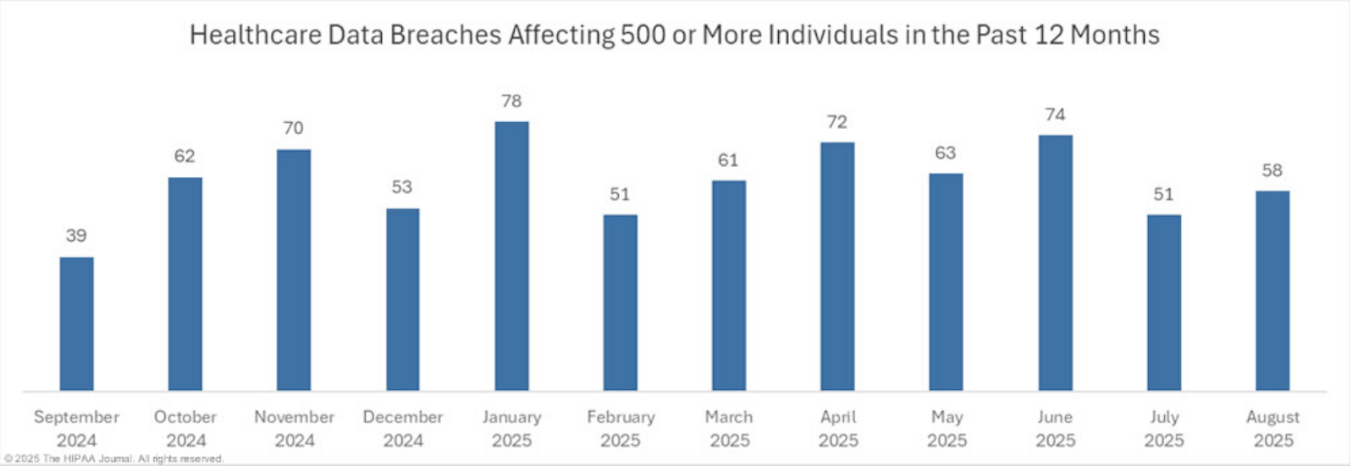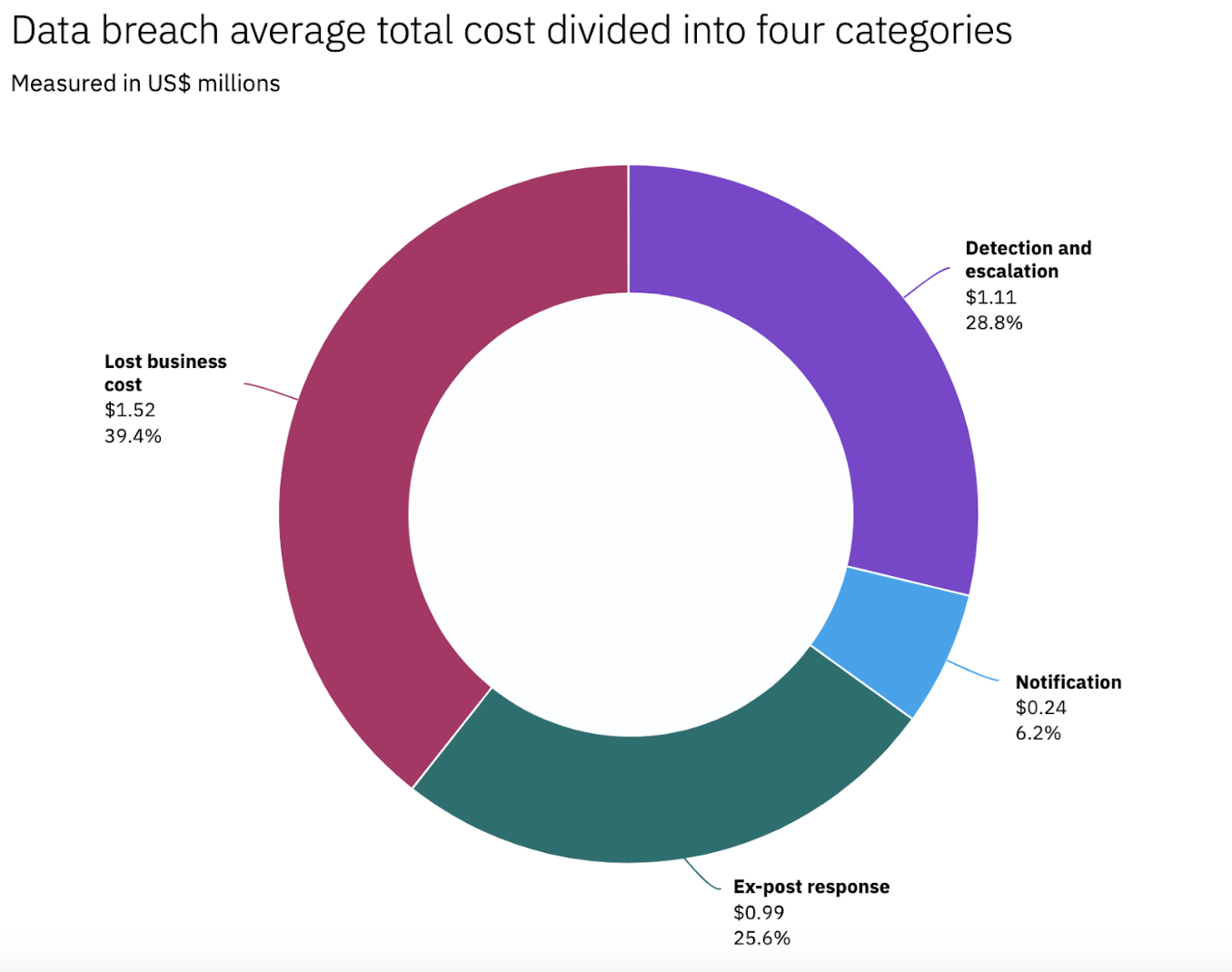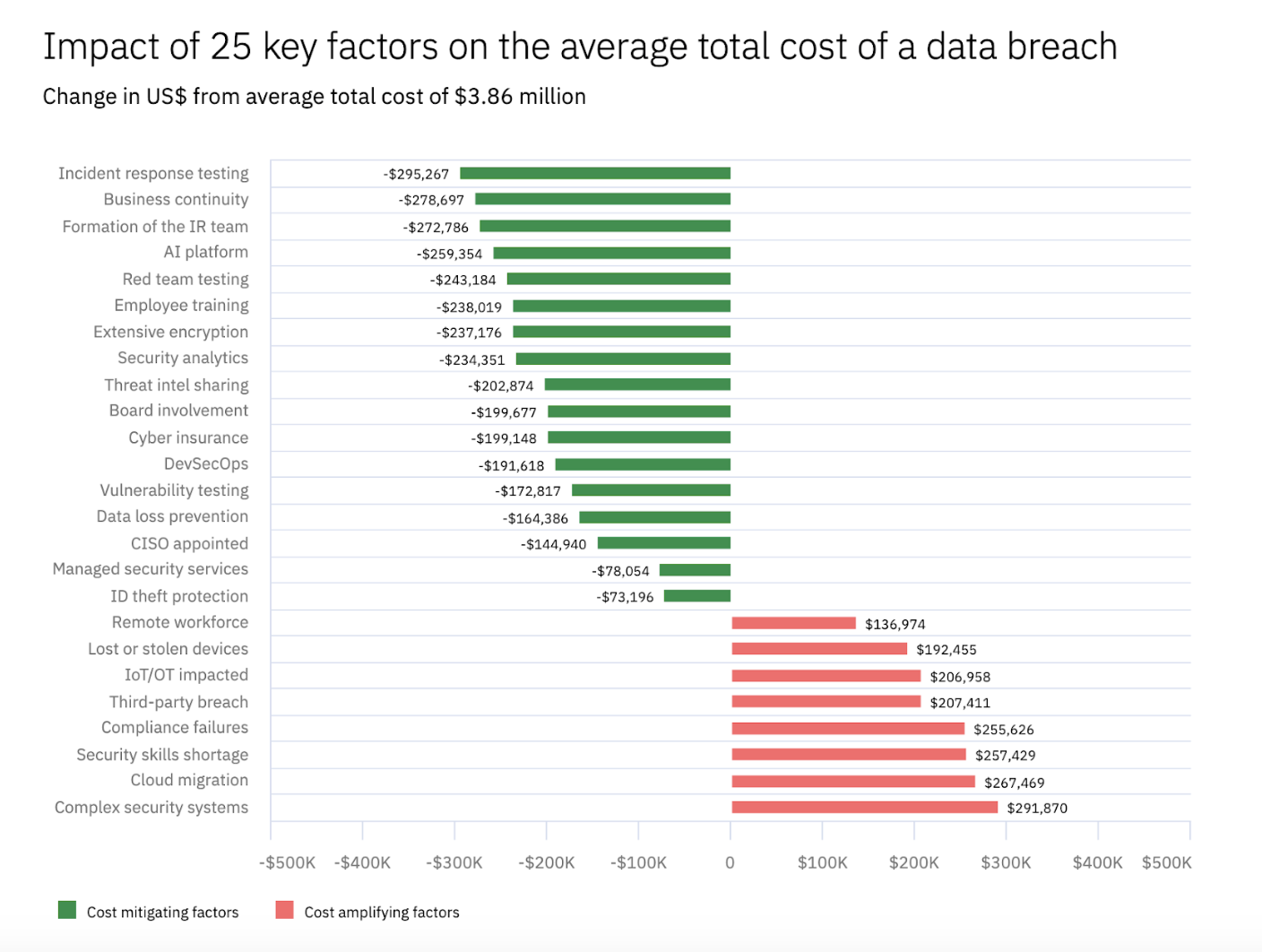
Consequences of a Data Breach in Healthcare: Lessons from the CPAP Medical Cyberattack
In December 2024, a cyberattack hit CPAP Medical Supplies and Services, a Florida-based company that supplies sleep apnea equipment. This attack exposed the private information of over 90,000 patients, including U.S. military members and their families. This incident, which went undetected for more than six months, is not simply a one-off event. It serves as a vital lesson for the entire healthcare industry, demonstrating how fragile many systems remain and how serious the fallout can be in today’s threat environment.
What this breach shows us is that the consequences of a single security failure extend well beyond the IT department. Such failures can trigger massive financial, legal, and regulatory problems that threaten a company's ability to operate smoothly and seriously harm patient trust.
 Source: The HIPAA Journal
Source: The HIPAA Journal
Anatomy of a Breach: Deconstructing the CPAP Medical Incident
A close look at the CPAP Medical cyberattack lets us follow the timeline step by step, exposing exactly where threat detection and incident response missed the mark. Those missed marks turn into practical lessons that every healthcare leader needs to consider. Between December 13 and December 21, 2024, an unauthorized actor gained and maintained access to CPAP Medical's network environment. This was not a fleeting intrusion; the attackers had persistent access for over a week, giving them ample time to navigate the network, identify high-value data, and exfiltrate a significant volume of sensitive files. The breach exposed an extensive data set, placing the 90,133 impacted individuals at a serious, long‑term risk of identity theft and financial fraud. According to the breach notice, the compromised information consisted of a dangerous blend of personal identifiers and protected health information (PHI):- Core Personal Identifiers: Full names, dates of birth, and Social Security numbers.
- Financial Data: Financial and banking account information.
- Protected Health Information (PHI): A broad category including medical information and health insurance details.
 Source: IBM Security
Source: IBM Security
What are the financial consequences of a healthcare data breach?
A data breach in healthcare triggers a financial impact unlike any other. Because medical records command a premium price, regulators impose strict compliance costs, and the ensuing operational chaos can be profoundly disruptive.The Staggering Industry Benchmarks
For the 14th consecutive year, the healthcare industry has incurred the highest average data breach costs of any sector. The 2023 IBM Cost of a Data Breach Report shows that a breach now costs a typical healthcare organization about $10.93 million on average, a record‑high figure that dwarfs the roughly $5.9 million average seen in the finance sector. This gap underscores how health data’s premium value, coupled with the sector’s intricate and often under‑funded IT landscapes, drives uniquely steep breach costs. Source: IBM Security
Source: IBM Security
Deconstructing the Costs
The total financial impact is a complex mix of direct, out-of-pocket expenses and more damaging indirect costs that can linger for years. Direct Costs are the immediate expenses required to manage the crisis:- Incident Response and Forensics: Engaging external cybersecurity experts to investigate the breach, contain the threat, and secure the network is a substantial, immediate cost.
- Notification and Services: The administrative expenses of notifying tens of thousands of individuals are significant. As a precaution, CPAP Medical offered complimentary credit monitoring and identity theft protection services, representing a direct per-victim cost.
- Regulatory Fines: As detailed later, potential civil money penalties from the Department of Health and Human Services (HHS) for HIPAA violations can easily run into the millions of dollars.
- Lost Business and Reputational Damage: IBM reports that lost business makes up the biggest slice of data‑breach expenses at roughly 40 % of the overall financial hit. For a niche supplier such as CPAP Medical, which caters to a tightly‑knit military clientele, a breakdown in trust can be especially harmful.
- Operational Disruption: When a security breach occurs, it forces many internal teams to shift their focus entirely to managing the crisis. This results in systems being unavailable, projects falling behind schedule, and a significant drop in overall productivity, all of which can seriously hinder a company's ability to function.
- Legal Expenditures: After a breach, companies often find themselves defending against numerous class-action lawsuits. The expenses associated with these legal battles, including attorney fees and any settlements that might be required, can quickly become one of the most substantial and unpredictable financial burdens.
The Legal Gauntlet: Navigating Class Actions and Liability
When a healthcare data breach becomes public, the legal response usually kicks in right away. In fact, just a few days after CPAP Medical announced the incident in August 2025, several law firms went public with formal investigations. Those early moves are essentially the first step toward filing class‑action lawsuits on behalf of the 90,133 people whose data was compromised. The lawsuits are expected to focus on negligence—essentially, that CPAP Medical owed patients a duty to safeguard their data and fell short of putting reasonable cybersecurity measures in place. The fact that the breach went unnoticed for six months will likely be the core piece of evidence. Plaintiffs’ lawyers will argue that this “unreasonable delay” robbed patients of the chance to act, and do things like freeze their credit, leaving them exposed to identity theft and financial fraud for months.The Regulatory Reckoning: A HIPAA Compliance Breakdown
Beyond civil lawsuits, the CPAP Medical breach triggered a mandatory and intensive regulatory review by the HHS Office for Civil Rights (OCR), the primary enforcer of HIPAA. This process places the organization's security practices under a microscope, with the potential for severe financial penalties. The HIPAA Breach Notification Rule requires organizations to notify affected individuals "without unreasonable delay and in no case later than 60 calendar days after discovery of a breach". The discovery date is defined not just as when an organization actually knows of a breach, but when it should have known by exercising "reasonable diligence." CPAP Medical may have hit the 60‑day deadline after the June 27, 2025 discovery, but regulators will be looking closely at the six months that came before. Not having a system in place to spot an intrusion for half a year could be viewed as a fundamental compliance shortcoming. OCR imposes penalties based on a tiered structure reflecting an organization's culpability.- Tier 1 (Lack of Knowledge): The entity could not have known about the violation.
- Tier 2 (Reasonable Cause): The entity should have known, but it was not due to willful neglect.
- Tier 3 (Willful Neglect - Corrected): The violation was due to willful neglect but was corrected within 30 days.
- Tier 4 (Willful Neglect - Not Corrected): The violation was due to willful neglect and was not corrected in a timely manner.
How can healthcare organizations prevent data breaches?
Moving from a reactive to a resilient security posture requires a strategic, multi-layered approach. A compliance-focused, checklist mentality is no longer sufficient to defend against modern threats.Adopting a Proactive Cybersecurity Framework
A practical risk model like the NIST Cybersecurity Framework gives teams a clear blueprint for a mature security program built on five core functions: Identify, Protect, Detect, Respond, and Recover. The CPAP Medical breach is a sharp reminder of what happens when Detect falls short. Real resilience comes from steady investment across all five. That means running annual HIPAA Security Risk Analyses, enforcing tight access controls, deploying continuous security monitoring, and keeping an incident response plan that is trained, tested, and ready to use.Building a HIPAA-Compliant Cloud Infrastructure
As healthcare organizations migrate to the cloud, understanding the shared responsibility model is critical. The cloud provider secures the infrastructure, but the healthcare organization remains fully responsible for securing its data and applications in the cloud. Choosing the right cloud service provider requires a detailed comparison of Azure, AWS, and GCP for HIPAA compliance and a clear HIPAA-compliant cloud strategy to ensure all regulatory requirements are met.Managing Ecosystem and Interoperability Risks
Modern healthcare is a deeply interconnected ecosystem where data sharing is crucial for patient care. However, this interconnectivity introduces significant security risks. Safely overcoming barriers to healthcare interoperability requires a commitment to industry standards like HL7 FHIR and the implementation of secure Application Programming Interfaces (APIs). Third-party integrations, particularly with Electronic Health Record (EHR) systems, represent a major source of risk. Organizations must implement secure EHR integration solutions and conduct exhaustive vendor risk assessments before connecting any external service to their network.Securing the Software Development Lifecycle (DevSecOps)
You’ll often find security vulnerabilities creeping into software during development, even when teams have no intention of leaving any gaps. A DevSecOps approach, which builds security practices and automated testing into every stage of the development lifecycle, provides a proven way to cut that risk. This security-by-design mindset is especially important now with all the new healthcare software development trends like AI tools, telemedicine platforms and mobile health apps. Each of those adds fresh attack surfaces. Source: IBM Security
Source: IBM Security
How Kanda Can Help
The CPAP Medical cyberattack illustrates how aging systems, tough privacy standards, uneven data formats and gaps in monitoring can leave patient data dangerously exposed. Partnering with a custom software team gives you the advantage in protecting sensitive healthcare data, maintaining compliance and ensuring patient trust.- Build Secure and Compliant FHIR Platforms: Develop secure, scalable, and compliant FHIR servers and APIs tailored to specific organizational needs. Reduce vulnerabilities and enable safe, real-time data exchange.
- Manage Legacy System Integration: Transform HL7 V2 messages into FHIR resources through secure, controlled pipelines, closing the gaps that attackers often exploit in older systems.
- Develop Secure, Interoperable Applications: Design and build patient-facing mobile apps, clinician decision support tools, and analytics dashboards that leverage the full power of FHIR, while keeping sensitive PHI protected.
- Compliance-by-Design and DevSecOps: Build security and regulatory requirements directly into platforms and integrations, ensuring that HIPAA, NIST, and industry standards are met proactively, not retroactively.
Conclusion
The CPAP Medical breach serves as a layered warning for the whole healthcare field. It shows that missing a threat, even when you’ve taken steps to prevent one, can be just as costly as a lapse in prevention itself, triggering a cascade of financial, legal and reputational fallout. What the incident really drives home is that regulators judge compliance not by how you react after a breach, but by the concrete evidence you have of proactive security measures that were in place long before anything went wrong. Moving forward means changing the way we think about cybersecurity. It shouldn’t be treated merely as a technical expense; rather, it’s a strategic asset that protects patient trust, keeps operations running smoothly, and supports long‑term financial health. By embracing up‑to‑date standards and working with security‑focused partners, the healthcare industry can unlock the full value of its data and deliver safer, more effective care.Related Articles

Healthcare Web Development: The Fastest Route to Scalable Patient Care
Outdated medical software is becoming a rising problem for healthcare facilities across the US, yet the push for digital patient experiences continues to grow. A CDC study found that 47.7% of adults ages 30-44 use the internet to communicate with a doctor or doctor's office. However, still existing paperwork, manual processes and legacy systems prolong…Learn More
RPA in Healthcare: Smarter Operations for Better Patient Care
The healthcare industry today is not only struggling with growing administrative spending but also with the increasing rates of staff burnout in healthcare facilities due to the high volume of repetitive tasks. As per Statista, 58% of registered nurses report burnout on most days, which results from both excessive emotional stress, the growing workload and…Learn More
Conversational AI for Healthcare: Changing How Patients Experience Care
The U.S. healthcare system has a serious problem with communication and management. Much of the strain comes from staggering administrative burdens. Research shows that physicians may spend nearly half of their clinic day devoted to documentation and non-clinical work. This imbalance damages the quality of care, makes it harder for people to access help, and…Learn More
Health Insurance Software Development: AI for Prior Authorization
Prior authorization (PA) was supposed to serve as a safety net, checking that patients get the right treatment while keeping costs in check. In reality, it now sits among the biggest administrative hurdles in healthcare. The contrast is stark when you consider how fast the market is growing. The U.S. healthcare software-as-a-service sector was worth…Learn More

